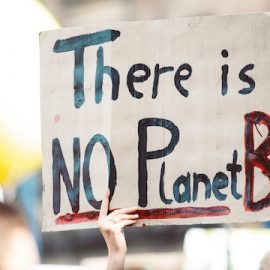

This article is an excerpt from the Shortform book guide to "Numbers Don't Lie" by Vaclav Smil. Shortform has the world's best summaries and analyses of books you should be reading.
Like this article? Sign up for a free trial here.
What percentage of carbon emissions come from transportation? Is it possible to eliminate CO2 emissions in the transportation industry?
Statistics show that one of the most significant contributors to carbon emissions is transportation/shipping. According to Vaclav Smil, the author of Numbers Don’t Lie, it would take a radical change to go carbon-neutral in these industries.
Let’s look at the numbers behind the carbon footprint of the transportation and shipping industries.
Diesel Engines Will Continue to Dominate
According to Smil, diesel engines are an integral part of the globalized economy. Diesel engines are much more efficient (15 to 20%) than their gasoline-powered counterparts, and they are reliable, durable, and have relatively low operating costs. Because of this, they power virtually every container ship, truck, and freight train, moving our most important commodities (oil, cement, grain) around the world. There is simply no better way to transport the massive amount of materials than diesel engines, and this will remain true for the foreseeable future.
(Shortform note: While we aren’t getting rid of diesel engines any time soon, there are some new technologies that may drastically reduce emissions from the transport sector. A Swedish transport company is using over 50 vehicles that run on HVO 100, a synthetic biodiesel, and they hope to further reduce energy consumption by designing more aerodynamic trucks. Additionally, researchers at MIT have devised a new way of powering trucks using a hybrid engine system that could also sharply reduce pollution.)
Electric Container Ships Won’t Be Efficient Enough in the Short Term
Though we’ve successfully built electric trains and cars, Smil points out that building efficient electric container ships will be a monumental task. The first electric container ship, built in the late 2010s, can only carry 120 containers, will travel at a slow speed of six knots, and will only be used for trips of up to 30 nautical miles. In contrast, diesel-powered container ships can carry over 20,000 standard-sized containers, travel at a speed of 16 knots and commonly make trips of over 20,000 kilometers.
To match the production of diesel, container ships would require lithium-ion batteries over 10 times more efficient than what we have today. To put this in perspective, in the last 70 years the efficiency of commercial batteries hasn’t even quadrupled.
(Shortform note: Besides electric container ships, there are other more environmentally friendly ships in the works, but they, too, are a long way from replacing diesel-powered cargo ships. One ship design, Vindskip, is partially powered by wind, and early tests have seen a 63% reduction in carbon emissions. But the earliest these ships could hit the waters is 2025. Another Norwegian ship design is meant to use hybrid propulsion systems to save energy and fuel, but again, these are hardly going to make a dent in near-term carbon emissions.)
Both Carbon-Producing Cars and Electric Vehicles Produce Significant Emissions
Smil argues that the age of the car began on August 12, 1908. This was the day the first Model T was assembled, making cars a much more affordable commodity. The automobile has had an enormous impact on the world but is also a major contributor of carbon emissions.
We’ll look at the numbers behind vehicles to explain why they are so inefficient as a means of transportation and why electric cars won’t save us.
Cars Use Energy Inefficiently
According to Smil, the main reason cars are energy-inefficient is their large weight-to-payload ratio—in other words, the weight of the car versus the weight of the people it’s carrying. This means it takes a huge amount of energy simply to move the car itself, not the passengers in it. For comparison, a Ford F-150, the most popular American car, has a ratio of 32, a bike has a weight ratio of 0.1, and a Vespa scooter 1.6 (for an average-sized human).
To make matters worse, in the US, almost three-quarters of Americans commute to work without other passengers, so the weight-to-payload ratio is especially bad. What’s more, the average car size is only increasing, especially with the heavy batteries required for electric cars. And while lighter cars would help, having fewer people drive alone would be the best thing to do to reduce the weight ratio of cars.
Electric Vehicles Also Produce Significant Carbon Emissions
While electric vehicles (EVs) can help with reducing the overall carbon footprint of transportation, Smil argues that they aren’t an effective means of fully displacing carbon just yet. First, since global electricity still mostly comes from fossil fuels, simply powering EVs will continue to be a source of carbon emissions. Further, as we’ve discussed, building the infrastructure for renewable energy takes fossil fuels, so even getting to the point where many people drive sustainably powered EVs will require a lot of carbon, as will producing the EVs.
To add to this, EV production also creates about three times as much toxicity as a gas-powered car. This is due to the use of more heavy metals, which are more toxic to both humans and our freshwater sources.
Airplanes Would Need to Run on Biofuel to Reduce Their Carbon Footprint
According to Smil, the numbers show that eliminating the carbon footprint of air traffic will be another great challenge of a transition to a carbon-free world. Airplanes use kerosene-based jet fuel, and there is currently no viable alternative to that. The best alternative may be fuel from organic matter, but to meet the increasing demand for air travel with biofuel, we’d need to cultivate oil-rich crops, which have their own environmental issues (more on this later).
Further, like container ships, making electric airplanes will be difficult, as batteries are heavy and a plane needs to be as light as possible to function properly. Of course, the most practical and effective way to limit airplane emissions would be to limit air traffic, but airplane use is expected to continue growing in the coming years.
(Shortform note: Like Smil, scientists seem to think one of the best ways to curb the carbon emissions of airplanes is to use biofuel. The most promising biofuel for this purpose comes from the camelina plant. In 2009, researchers found that oil from camelina can be converted to a green jet fuel that meets the standards of current petroleum jet fuels. The widespread use of camelina jet fuel could reduce carbon emissions of air traffic by up to 84%. The biggest roadblock to this currently is the cost and availability of growing the camelina crop at the required scale.)
Trains Are an Excellent Medium-Distance Mode of Transportation
As Smil points out, no mode of transportation is as efficient for medium distances as a high-speed electric train. While high-speed trains can’t replace the intercontinental capacity of planes or the local capacity of cars, they’re the best option for travel between these extremes.
For inter-city travel, trains offer high speeds, convenience, and relatively low energy usage and carbon emissions. A high-speed train can cover 300 kilometers in just under two hours. This is just a little bit longer than an airplane takes at a fraction of the energy usage. While Europe and China have adopted the use of electric trains, the United States is lagging behind: There’s not a single high-speed train connecting major cities in the US.
(Shortform note: A 2021 study on the high-speed rail system in China highlights how much more efficient and environmentally friendly high-speed trains are than airplanes. The study estimates that air travel emits seven times more carbon per passenger than high-speed rail (HSR) travel. The extensive HSR system in China is reducing carbon emissions drastically, as people are switching from plane to HSR travel within China. This switch to HSR has reduced China’s air carbon emissions by approximately 18%, or 12 million metric tons, over the last few years.)

———End of Preview———
Like what you just read? Read the rest of the world's best book summary and analysis of Vaclav Smil's "Numbers Don't Lie" at Shortform.
Here's what you'll find in our full Numbers Don't Lie summary:
- How you can understand the world by understanding numbers and statistics
- Why the infant mortality rate is a better indicator of standard of living than GDP per capita
- Why nuclear energy is not the answer to sustainability






